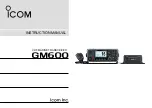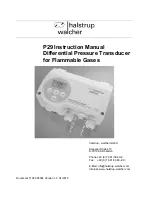
12
sensitivity. In case of an atmosphere with oxygen content of less than 17%, there measured value will be overvalued. In case of
an atmosphere with oxygen content of more than 25%, the measured value will be undervalued.
b)
electrochemical sensors:
Constant exposure to toxic gases or short-term exposure to gases, which greatly exceed the
maximum range of the sensor, can damage the electrochemical sensor, which requires recalibration or replacement. High
temperature along with low relative humidity have a negative effect on the sensor's lifetime. In case of an atmosphere with
oxygen content of less than 1% for longer than 1 hour, the measured value will be undervalued.
c)
infrared sensors
:
Vapor acids and alkalis can etch the optical system and distort the measurements. A check or a calibration
may be necessary.
d)
semiconductor sensors:
Short-term exposure to gases or vapors of organic solvents, which greatly exceed the maximum
range of the sensor, may damage the sensor and a recalibration or replacement may be required. In case of an atmosphere
with an oxygen content of less than 18 %, the measured value will be undervalued.
E)
photoionization sensors:
it is necessary to clean the UV lamp regularly, as its clogging of can cause loss of signal.
2.
Operation
To maintain proper operation of the transmitter it is necessary to respect the fact that the presence of certain concentrations
of gases or vapors, other than those for which the sensor is set, can cause an alarm, even if the concentration of the gas does
not exceed the set level. Given the range of disturbing gases or vapors (diluents, exhaust gases, vapors of organic substances,
disinfectants, etc.) a generally allowable concentration of interfering gases can not be determined. Data on cross-sensitivity to
certain gases are listed at the appropriate sensors. Therefore we recommend to have the air in the deployment area of the
detection system analyzed before processing project documentation.
3.
Operation/Maintenance
In case of contamination, the surface can be cleaned with a slightly moistened cloth.
The sensors have a different lifetime depending on the sensing technology used and on environmental conditions.
Characteristics of the sensors vary over time. Therefore it is required to perform regular checks and calibrations, which can
commence in two ways:
a)
1x
per
6 months
carry out a „
calibration“ and functional control
-
adjust the sensitivity of the sensor using calibration
gas and check the functionality of the system. The exact interval depends on the purity of the environment, required
accuracy and the occurrence of disturbing gases in the atmosphere.
b)
1x
per
12 months
carry out a „
calibration“
-
adjust the sensitivity of the sensor using calibration gas and check the
functionality of the system. The exact interval depends on the purity of the environment, required accuracy and the
occurrence of disturbing gases in the atmosphere. Also carry out a
„functional control" 1 x per
three months -
checking
the function of the entire detection system using a test gas, which does not exceed the range of the sensor. We
recommend using gas intended for laboratory use.
Perform calibration only at certified service centers with a valid certificate of competence or at the manufacturer.
For the Czech Republic only DEGA CZ s.r.o.
Accessories
1.
Additional bushing DEGA BUSHING for NBxIII
PG9
Basic type of transmitters
1.
Transmitters with a catalytic sensor NBx-CL III LCD RE
Transmitter type
Detected gas
Measurement
range
Measurement of
current loop
(4-20mA)
Standard alarm setting
Resolution
Calibration gas
DEGA NBM-CL III LCD RE
Methane (CH
4
)
Natural gas
CNG
0–100% DMV
0-20% DMV
1. st. 5% DMV, 2. st.10% DMV
3. st. 15% DMV, 4. st. 20% DMV
0,1% DMV
Methane 0,88
%



































